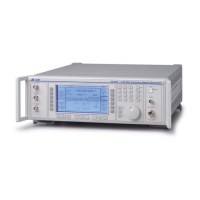INSTALLATION
2-9
Prior to carrying out any inspection and tests, the instruments must be disconnected from
the mains supply and all external signal connections removed. All tests should include the
instrument’s own supply lead, all covers must be fitted and the equipment supply switch must be
in the ‘ON’ position.
The recommended inspection and tests fall into three categories and should be carried out
in the following sequence:
1. Visual inspection
2. Earth bonding tests
3. Insulation resistance test
1. Visual inspection
A visual inspection should be carried out on a periodic basis. This interval is dependent
on the operating environment, maintenance and use, and should be assessed in accordance with
guidelines issued by the Health and Safety Executive (HSE). As a guide, this instrument when
used indoors in a relatively clean environment would be classified as ‘low risk’ equipment and
hence should be subject to safety inspections on an annual basis. If the use of the equipment is
contrary to the conditions specified, you should review the safety re-test interval.
As a guide, the visual inspection should include the following where appropriate:
Check that the equipment has been installed in accordance with the instructions provided
(e.g. that ventilation is adequate, supply isolators are accessible, supply wiring is adequate and
properly routed).
The condition of the mains supply lead and supply connector(s).
Check that the mains supply switch isolates the instrument from the supply.
The correct rating and type of supply fuses.
Security and condition of covers and handles.
Check the supply indicator functions (if fitted).
Check the presence and condition of all warning labels and markings and supplied safety
information.
Check the wiring in re-wireable plugs and appliance connectors.
If any defect is noted this should be rectified before proceeding with the following
electrical tests.
2. Earth bonding tests
Earth bonding tests should be carried out using a 25 A (12 V maximum open circuit
voltage) DC source. Tests should be limited to a maximum duration of 5 seconds and have a
pass limit of 0.1 Ω after allowing for the resistance of the supply lead. Exceeding the test
duration can cause damage to the equipment. The tests should be carried out between the supply
earth and exposed case metalwork, no attempt should be made to perform the tests on functional
earths (e.g. signal carrying connector shells or screen connections) as this will result in damage
to the equipment.
3. Insulation tests
A 500 V DC test should be applied between the protective earth connection and
combined live and neutral supply connections with the equipment supply switch in the ‘on’
position. It is advisable to make the live/neutral link on the appliance tester or its connector to
avoid the possibility of returning the equipment to the user with the live and neutral poles linked
with an ad-hoc strap. The test voltage should be applied for 5 seconds before taking the
measurement.

